Starting tomato seeds indoors matters a lot for a great harvest. It lets gardeners begin early, making the season longer. It also means you can pick from more tomato types and get fruit sooner, which lasts longer.1 This guide tells you everything you need, from the best time to plant to how to care for seedlings, and transplant them outside.
Key Takeaways
- Starting tomato seeds indoors allows for an extended growing season and earlier harvests.
- Indoor seed starting provides access to a wider variety of tomato cultivars, including heirlooms and specialty types.
- Proper timing and care of tomato seedlings are crucial for healthy transplants and a successful outdoor crop.
- Hardening off seedlings gradually prepares them for the transition to the garden.
- Addressing common issues like leggy growth or pests ensures the best possible tomato harvest.
Understanding the Importance of Starting Tomato Seeds Indoors
Starting tomato seeds indoors gives gardeners a jump on the season. They plant weeks ahead of the last frost. This way, they have strong seedlings to transplant outdoors early.
The plants then have more time to grow and yield a bigger harvest.
Extending the Growing Season
Planting indoors means plants bear fruit sooner after moving them outside. Plus, these tomatoes often keep producing longer, adding to your harvest time.2
Accessing a Wider Variety of Tomatoes
By growing tomatoes from seed, gardeners can select from many more types. They get access to heirlooms, special kinds, and unusual varieties not easily found elsewhere. This opens the door to trying different tastes, colors, and growth styles.
Early Harvest and Longer Fruiting Period
Indoor seed starting leads to harvesting earlier than with direct-sown seeds. It also means a longer season of ripe fruit.2
Determining the Optimal Time to Start Tomato Seeds
Start tomato seeds indoors 6-8 weeks before your area’s last spring frost date.2 This lets seedlings grow into strong plants ready for outdoor planting.3 Check a local frost date calendar or ask experienced gardeners to find the best time to plant.
Considering Your Last Frost Date
Figure out when to start tomato seeds indoors by looking at your last frost date.3 If the date is around May 10th, plant seeds indoors near March 29th.2 This way, your plants will be the right size for the garden when the weather is good.
Calculating the Right Planting Schedule
Normally, start tomatoes indoors from 6 to 8 weeks before your last frost.2 The timing might change based on your area’s weather and the tomato types.2 For bush tomatoes, begin 6 weeks before.2 Tumbler and dwarf plants can start earlier and move to bigger containers indoors.2 Only start indeterminate tomatoes super early if using specific growing methods.2
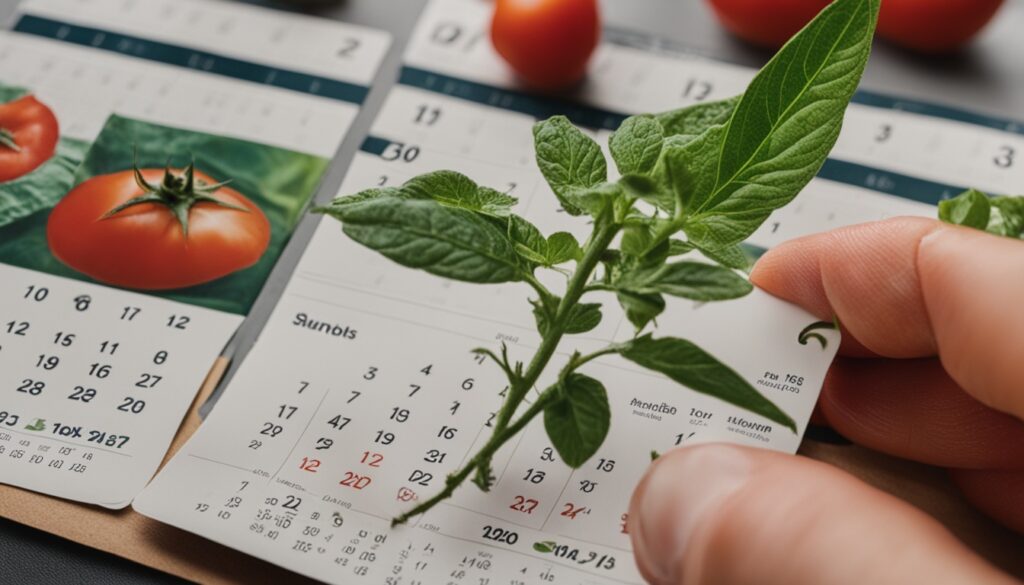
Preparing the Seed-Starting Containers and Materials
Tomato seeds can start in many containers. You can use seed-starting trays, old plastic containers, or make your own pots. Make sure these containers have holes for water to drain.1 Always clean used containers well before planting in them.
Choosing Suitable Containers
Use a good seed-starting mix for tomato seedlings. It should be light, drain well, and free of pests.1 Don’t use garden soil because it might be too heavy and carry diseases.
Selecting a Quality Seed-Starting Mix
Besides containers and mix, you need a spray bottle for watering. You also need labels to know which tomatoes are which. Don’t forget a small tool for moving the seedlings.1 These tools make starting seeds easier.
Gathering Essential Tools and Supplies
How to Start Tomato Seeds Indoors
Sowing the Seeds in the Seed-Starting Mix
First, dampen the seed-starting mix and fill containers. Plant 2-3 tomato seeds in each container, placing them 1 inch apart. Cover the seeds with 1/8 inch of mix.3 Use tweezers for the tiny seeds. Then, lightly mist the soil to keep them in place.
Providing Proper Moisture and Warmth for Germination
After planting, put the containers in a warm spot. Aim for a temperature of 75-80°F for quick sprouting in 5-10 days.3 Always keep the soil damp, but don’t overwater. Remove covers once they grow, and lower the heat to 50-70°F.
Labeling and Tracking Varieties
Label each container with the type of tomato you’re growing. Use popsicle sticks or plant tags to remember what’s planted where.
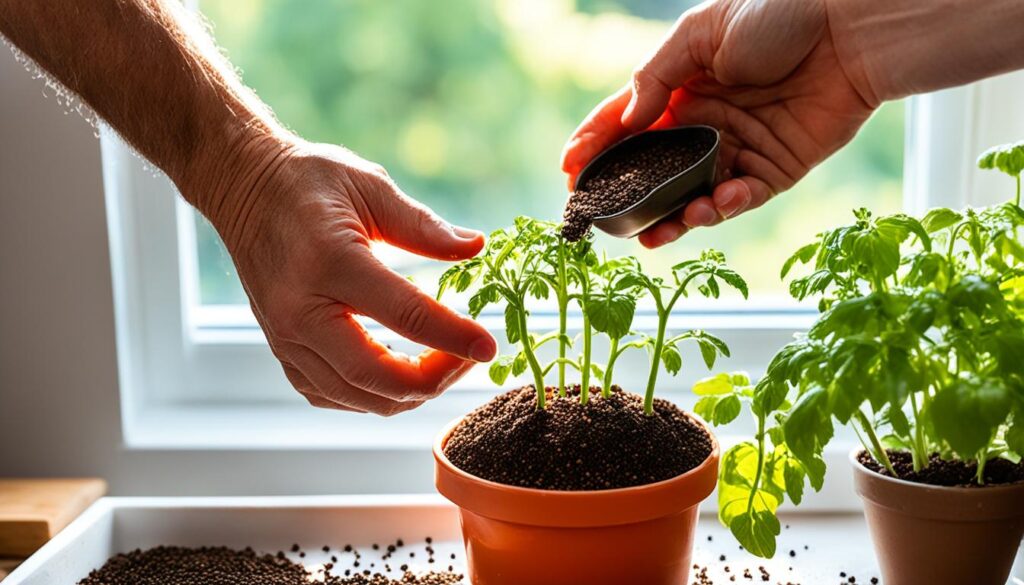
Caring for Tomato Seedlings
Tomato seedlings need 12-15 hours of sunlight each day to do well.1 If there’s not enough natural light, use a grow light. Put it a few inches above the plants and turn it on as needed. Move the plants around every now and then to keep them from growing too tall.
Keep the soil for your tomato seedlings damp, not soaking wet. Don’t let the plants dry out, as this can hurt them. After they grow their first real leaves, start feeding them weekly with a weak, organic liquid fertilizer. This feeds the plants what they need to grow strong and healthy.
Thinning and Transplanting Seedlings
Once your tomato seedlings show their true leaves, it’s time to thin them. Keep the healthiest plant and remove the others.1 Gently move the chosen seedling to a bigger pot. Ensure the new container has good potting mix and the stem is buried up to its leaves. This promotes better root growth.
Hardening Off and Transplanting Tomato Seedlings
Before planting tomato seedlings in the garden, they need to get used to the outside.4 For 7-10 days, let them see more sun, feel the wind, and handle cooler weather.4 Start with just a few hours a day outside, then increase the time.4 This slow start helps them adjust and not get too stressed when moved outdoors.
Gradually Exposing Seedlings to Outdoor Conditions
It takes a week to get tomato plants used to the outside.5 If they’re not used to the sun, wind, and shifting temps, they could get hurt.5 It’s best to start letting them outside 3-4 weeks after they sprout, when they have more leaves showing.4 Before that, move them to bigger pots.4 Keep them in the shade for the first days outside, and only leave them out at night if it’s warmer than 50 degrees F.5 Slowly get them used to all the light, wind, and weather.5
Preparing the Garden Bed for Transplanting
Get the garden bed ready for the tomato plants by adding compost and making sure the soil is over 60°F.5 The best times to plant are when the days and nights are warm.5 Aim to start the hardening off process when the chance of frost is gone.5
Properly Transplanting Seedlings into the Garden
When it’s time to transplant, be careful not to damage the roots as you move the seedlings.4 Put them in holes deep enough to bury the stem up to their first true leaves. This helps grow new roots.4 After planting, press the soil lightly around the base of each plant and make sure to water them well.5 Doing this right helps your tomatoes grow strong.5 Don’t worry too much if they face some tough weather; tomatoes are tough and can bounce back.4 If the leaves turn yellow from too much sun, it’s a sign you put them out too fast.4 Planting usually happens about a week after starting to harden them off, but it can change depending on the weather and the plant’s health.4
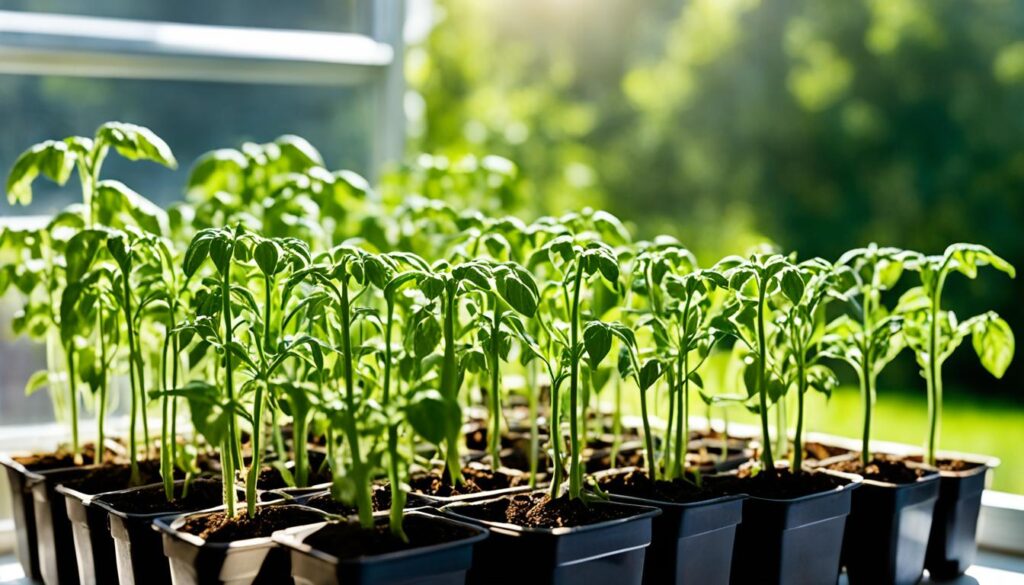
Troubleshooting Common Issues
If tomato seedlings grow too tall or look small, check the light and heat. They might need more sunlight or special grow lights. Also, make sure they’re not too hot or cold, which can slow their growth.6 Placing the stems deeper when you plant them can also help strong them.
Addressing Leggy or Stunted Growth
Watch your tomato plants for bugs or diseases like aphids, whiteflies, or fungi. If you see a problem, act fast. Use organic ways to control pests or improve the plant’s environment. This can stop big issues that hurt your plants.7
Preventing and Managing Pests and Diseases
If your seedlings look weak, with yellow leaves or not much growth, check the soil.8 The soil should drain well, be right pH, and have what the plants need. Changing the soil or its brand might fix this.
| Issue | Potential Causes | Recommended Solutions |
|---|---|---|
| Leggy or Spindly Seedlings | Insufficient light, extreme temperatures | Provide more direct sunlight or supplemental grow lighting; maintain optimal temperature range |
| Stunted Growth | Nutrient deficiencies, soil pH imbalance, overwatering | Amend soil with balanced nutrients, adjust pH, ensure proper drainage and watering |
| Pests and Diseases | Aphids, whiteflies, fungal issues | Use organic pest control methods, improve growing conditions to prevent infestations |
To help your tomato plants grow well, fix any problems early. Keep an eye on them and solve issues fast. This will keep your seedlings healthy and strong.
Growing Tomatoes Indoors All Year Round
Many gardeners plant their tomato seedlings outside in the spring. Yet, you can grow tomatoes inside all year.3 Choose tomato types that are small and don’t need a lot of space. Cherry, dwarf, and patio tomatoes are perfect for indoor gardens.
Providing Adequate Light and Warmth
To grow tomatoes inside, they need a lot of light, usually 12-15 hours a day.3 Keep the temperature between 65-85°F. Use bright windows and extra lights to help them grow.
Container Size and Soil Requirements
You should put tomatoes in large containers, at least 10 gallons.3 Fill the pots with a good potting mix for containers. Check the soil often for moisture. Fertilize every 2-3 weeks to help the tomatoes grow well.
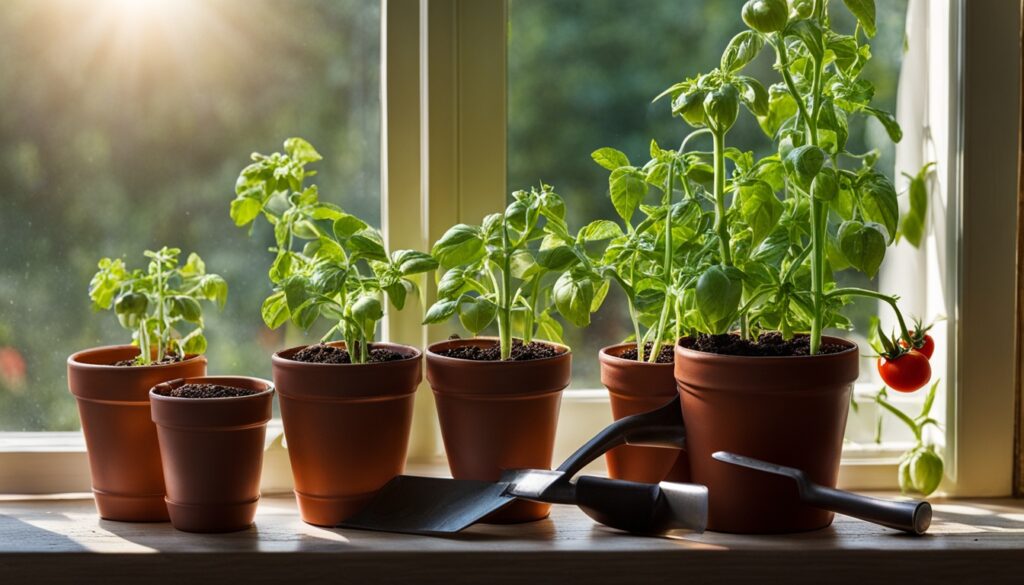
Tips for a Bountiful Tomato Harvest
Pruning and Trellising Techniques
Pruning tomato plants means removing side shoots and lower leaves. This directs the plant’s energy toward making more fruit.1 Use strong trellises or cages to keep the plants upright. This helps prevent the branches from snapping under the fruit’s weight.
Consistent Watering and Fertilizing
To keep the soil moist, water your tomato plants about 1-2 inches each week.1 Also, feed them a balanced fertilizer that dissolves in water every 2-4 weeks. These steps will give the plants the nutrients they need to grow well and produce plenty of fruit.
Harvesting and Enjoying Your Tomatoes
When picking tomatoes, choose them at their peak ripeness. Pick when they’re fully colored and a bit soft to touch.1 For heirloom or special kinds, wait until they’re fully mature to pick. Use your fresh tomatoes in many foods, from salads to sauces and preserves. It’s a great way to enjoy what you’ve grown at home.
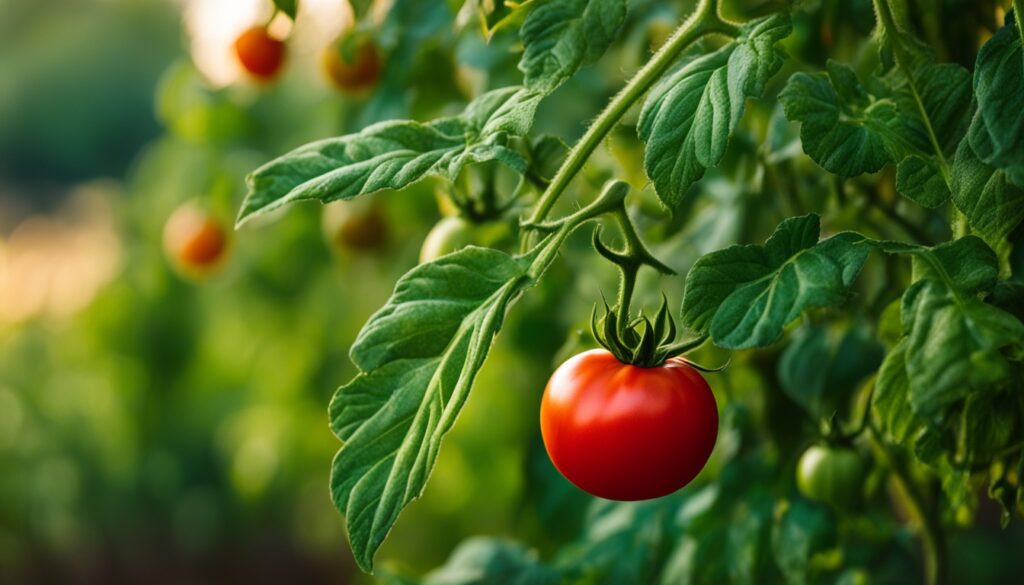
Conclusion
Starting tomato seeds indoors is both rewarding and important for a big tomato harvest. It lets you grow tomatoes for more time9. You also get to choose from many types of tomatoes10. This means you start harvesting earlier and keep getting tomatoes for longer9. Gardeners will find success by taking this step.
This guide offers everything you need to start indoor tomato seeds well. You’ll learn the best time to plant them10. You’ll get tips on what you need and how to take care of your plants. With careful steps, you can become a confident indoor gardener.10
With the advice in this article, you can have a great indoor tomato garden. Enjoy the taste and freshness of your hard work. Start this fulfilling journey and watch your love for gardening grow with every tomato harvest.
FAQ
What are the benefits of starting tomato seeds indoors?
Starting tomato seeds indoors offers several advantages. It extends the growing season. You get a chance to grow different types of tomatoes.
Also, you can start harvesting earlier and keep getting tomatoes for longer.
When is the optimal time to start tomato seeds indoors?
The best time is about 6-8 weeks before the last frost. This could vary based on where you live.
What type of containers and seed-starting mix should I use?
Use any container with drainage holes, like trays or old plastic. Just ensure there’s room for the roots to grow.
For the soil, a sterile mix made for starting seeds is best. It helps the seedlings grow strong and healthy.
How do I properly care for tomato seedlings?
Tomato seedlings love lots of sunlight. They need at least 12 hours a day.
Keep the soil moist and give them diluted, organic fertilizer every week. As they grow, move the strongest seedlings to bigger pots.
How do I harden off and transplant the tomato seedlings?
Before planting them outside, get the seedlings used to the weather. Start by putting them out for a few hours a day.
After a week, they should be ready to stay outside. Plant them deep, up to their first true leaves. This helps them grow stronger roots.
How can I grow tomatoes indoors year-round?
Select tomato types that stay small and bear fruit quickly. Ensure they get 12-15 hours of light each day.
Keep the room warm. Use containers at least 10 gallons big with good, well-draining soil.
Source Links
- https://www.reneesgarden.com/blogs/gardening-resources/starting-tomato-seeds-indoors-technique-tips-with-photos
- https://northernhomestead.com/when-to-start-tomatoes-indoors/
- https://www.bhg.com/how-and-when-to-start-tomato-seeds-indoors-8417120
- https://farmtojar.com/tips-for-hardening-off-tomato-and-pepper-seedlings/
- https://savvygardening.com/how-to-harden-off-tomato-plants/
- https://www.espoma.com/gardening/3-common-seed-starting-problems-and-how-to-fix-them/
- https://melissaknorris.com/podcast/seed-starting-problems/
- https://homesteadingfamily.com/seed-starting-problems-how-to-fix-them/
- https://www.lostcoastplanttherapy.com/blogs/news/growing-tomatoes-indoors
- https://meadowlarkjournal.com/blog/when-to-start-tomato-seeds-indoors
